Best Air Conditioners for Dorm Rooms
When choosing an air conditioner for a dorm room, a portable air conditioner stands out as the ideal solution for its ease of use, efficiency, and convenience. Dorm rooms are typically small, so selecting the best air conditioner involves considering factors such as room size, noise levels, energy efficiency, and portability. With a wide variety of options on the market, it’s important to narrow down the choices based on these key criteria to ensure comfort and affordability.
Portable Air Conditioners
Portable air conditioners are a perfect choice for dorm rooms because they do not require installation and can easily be moved around. These AC units are ideal for small spaces like dorms where permanent installation (like window units) isn’t possible or desirable. Portable ACs work by pulling warm air from the room and cooling it through refrigeration before blowing the cool air back into the room. Most models include a venting system that pushes warm air out through a window.
Key benefits of portable air conditioners include:
- Mobility: Easy to relocate and store when not in use.
- No Installation Required: Perfect for renters or students.
- Energy Efficiency: Many models are designed to consume less power, saving on electricity costs.
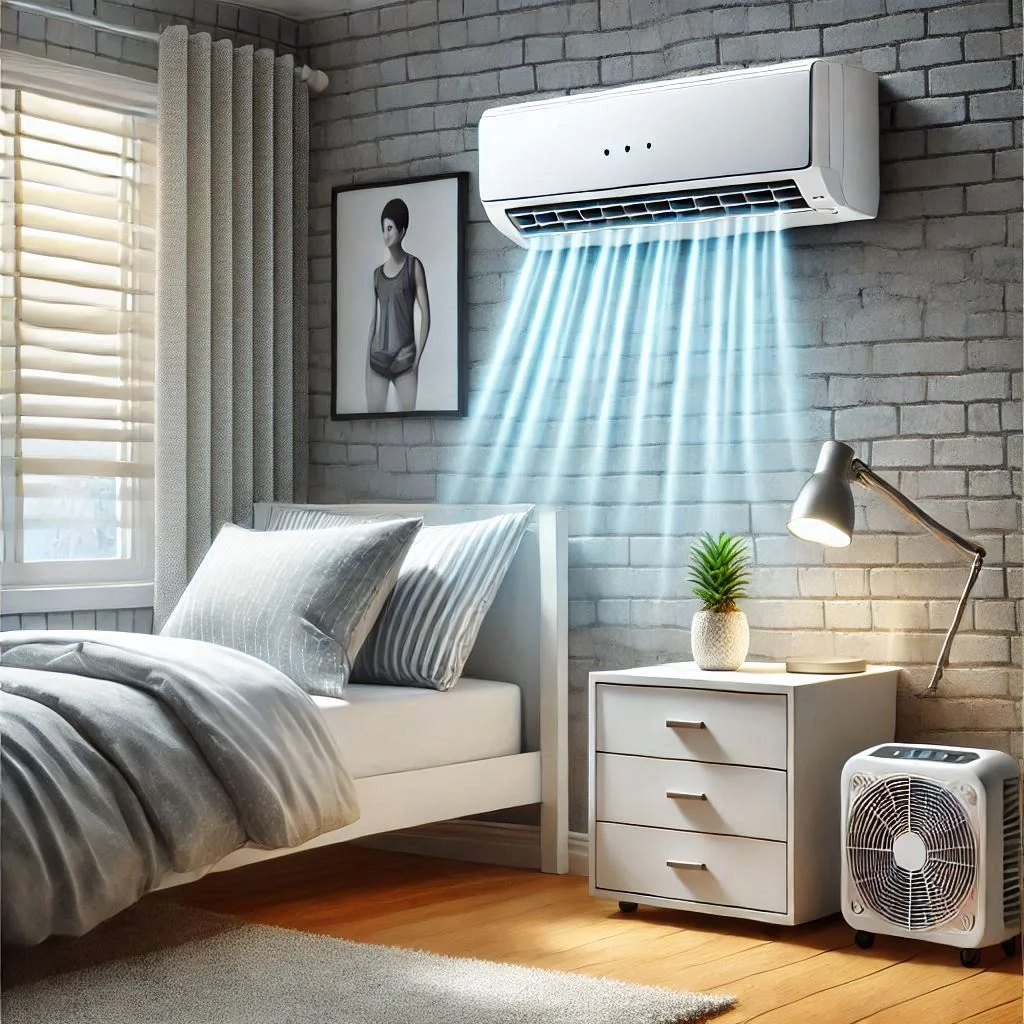
What to Look For When Buying a Portable Air Conditioner
When shopping for a portable air conditioner for a dorm room, consider the following features to ensure you select the best model:
Smart Functionality
Modern portable air conditioners often come equipped with smart features such as Wi-Fi connectivity, app control, and voice activation. This allows users to control the temperature and settings remotely via smartphones or voice assistants like Alexa or Google Assistant. With this feature, you can adjust your room’s temperature without leaving your bed or desk.
- Why it’s important: Convenient for tech-savvy users and helps save energy by adjusting settings remotely when not in the room.
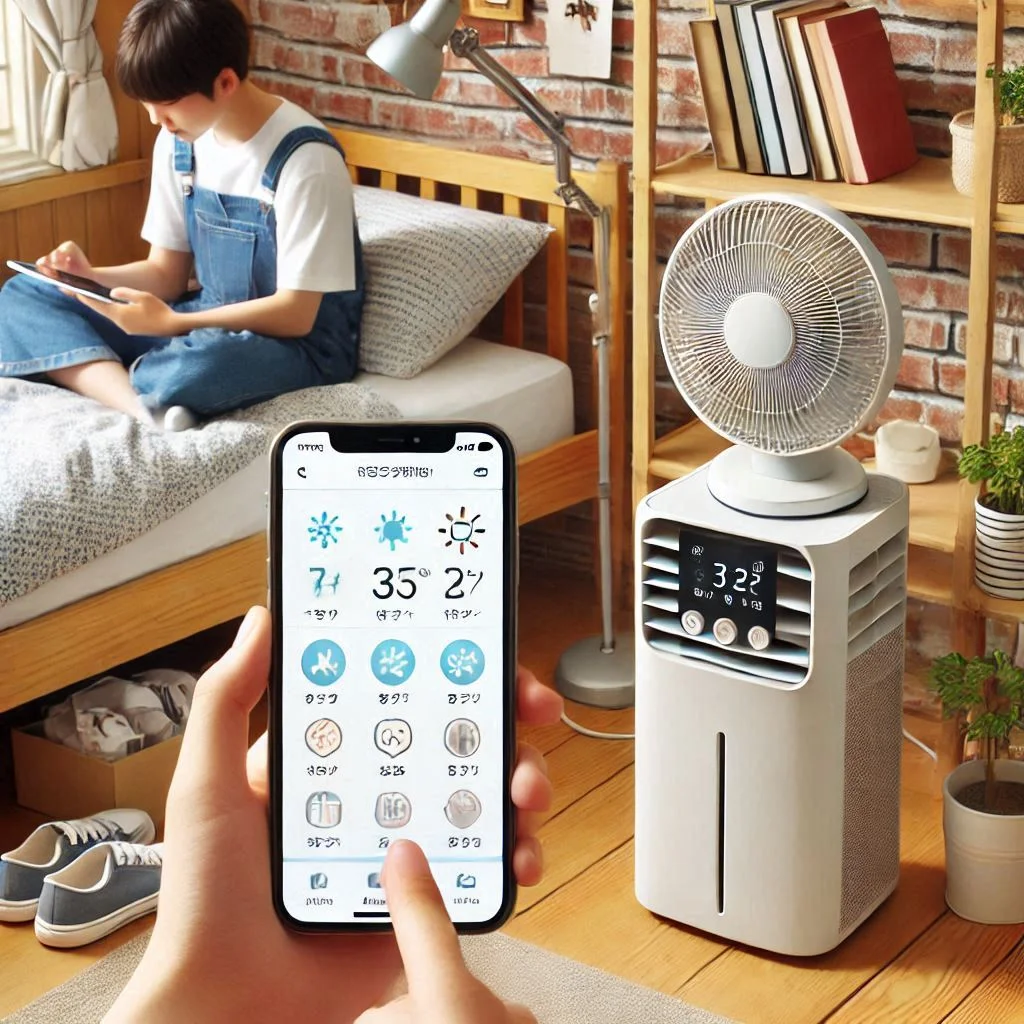
Sizing
Choosing the right size is crucial when buying a portable air conditioner for a dorm room. The cooling capacity of an air conditioner is measured in BTUs (British Thermal Units), and selecting the right capacity will ensure effective cooling.
- Smaller dorm rooms (up to 200 sq ft): Look for AC units with 6,000–8,000 BTUs.
- Medium-sized dorm rooms (200-350 sq ft): AC units with 8,000–10,000 BTUs are suitable.
The right size will cool the room without overworking the air conditioner, ensuring longer-lasting use and energy efficiency.
Noise
Noise level is another crucial consideration when choosing a portable air conditioner. Dorm rooms often have thin walls, and the constant hum of an air conditioner can disrupt your studies or sleep. Look for models that operate at lower decibel levels (dB).
- Ideal range: Aim for units with noise levels around 50-55 dB, which are quieter than typical household appliances.
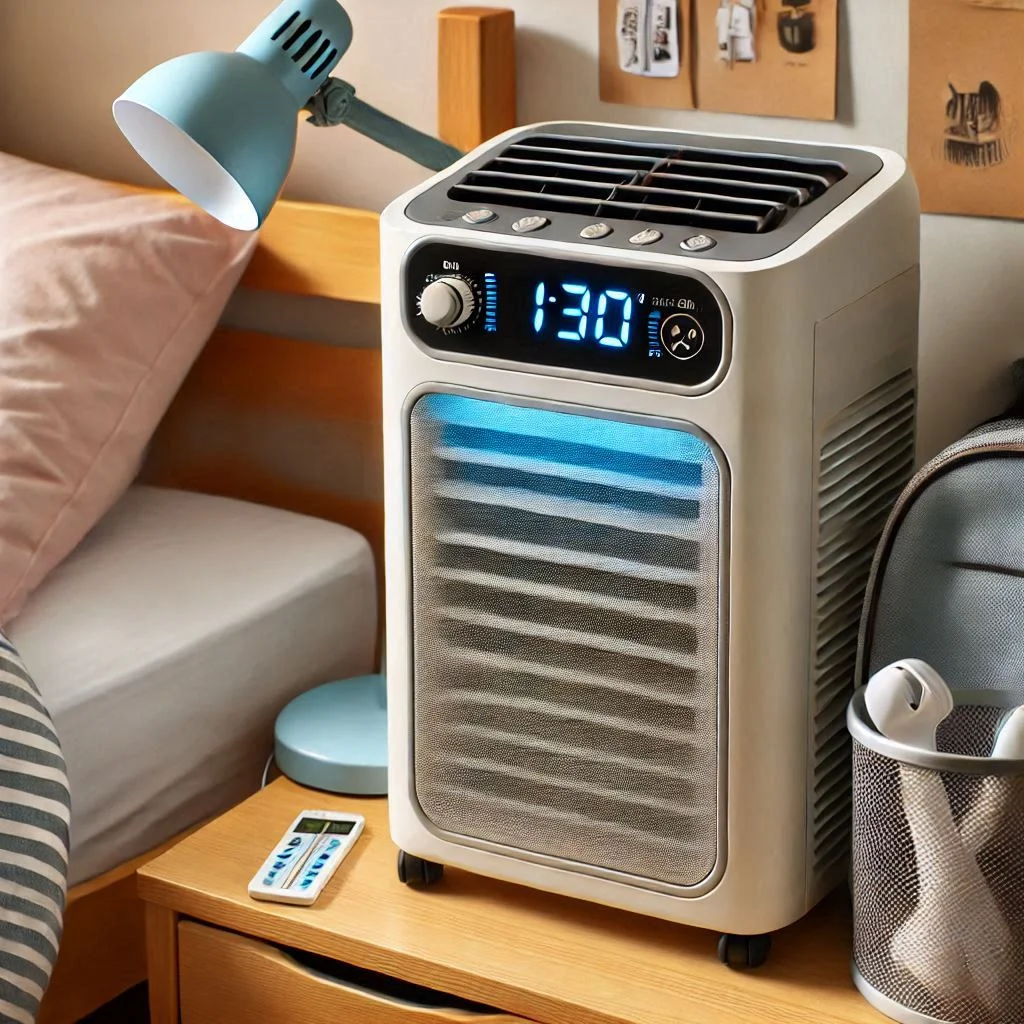
Placement
The placement of the portable air conditioner is important to ensure optimal airflow and cooling efficiency. Typically, portable AC units need to be placed near a window for venting hot air outside. Ensure there’s enough space for the unit to operate effectively without obstructions.
- Tip: Place the air conditioner in a central location where it can circulate air throughout the room, but avoid placing it in direct sunlight or near heat sources, as this can reduce its cooling effectiveness.
Efficiency
Energy efficiency is a critical factor when selecting an air conditioner, especially for students trying to minimize electricity bills. Look for models that are Energy Star rated. These units consume less power while maintaining effective cooling performance. Also, consider ACs with auto mode or sleep mode, which adjust the cooling based on your preferences and room temperature.
- Why it’s important: Helps lower electricity bills and is environmentally friendly.
Top Portable Air Conditioners for Dorm Rooms
When choosing the best portable air conditioner for a dorm room, it’s essential to pick a model that combines powerful cooling, energy efficiency, and ease of use. Here are three of the top-rated portable air conditioners that are perfect for dorms:
FHPH132AB1 Portable Room Air Conditioner by Frigidaire
The Frigidaire FHPH132AB1 is a top contender for dorm room cooling thanks to its impressive cooling capacity, user-friendly features, and compact design. With a 12,000 BTU rating, this unit is powerful enough to cool medium to large dorm rooms (up to 550 square feet). It’s equipped with an auto mode, which adjusts the cooling to match the room temperature, and comes with an energy-saving mode to optimize power consumption.
Key Features:
- Cooling Capacity: 12,000 BTUs, ideal for larger dorm rooms.
- Energy Efficiency: Features an Energy Star rating, ensuring it uses less electricity.
- Smart Features: Includes a remote control, auto restart, and programmable timer.
- Quiet Operation: Runs at a noise level of around 55 dB, making it a relatively quiet option for dorms.
This portable air conditioner is an excellent choice for students looking for a reliable and energy-efficient solution to cool their dorm rooms while keeping noise levels low.
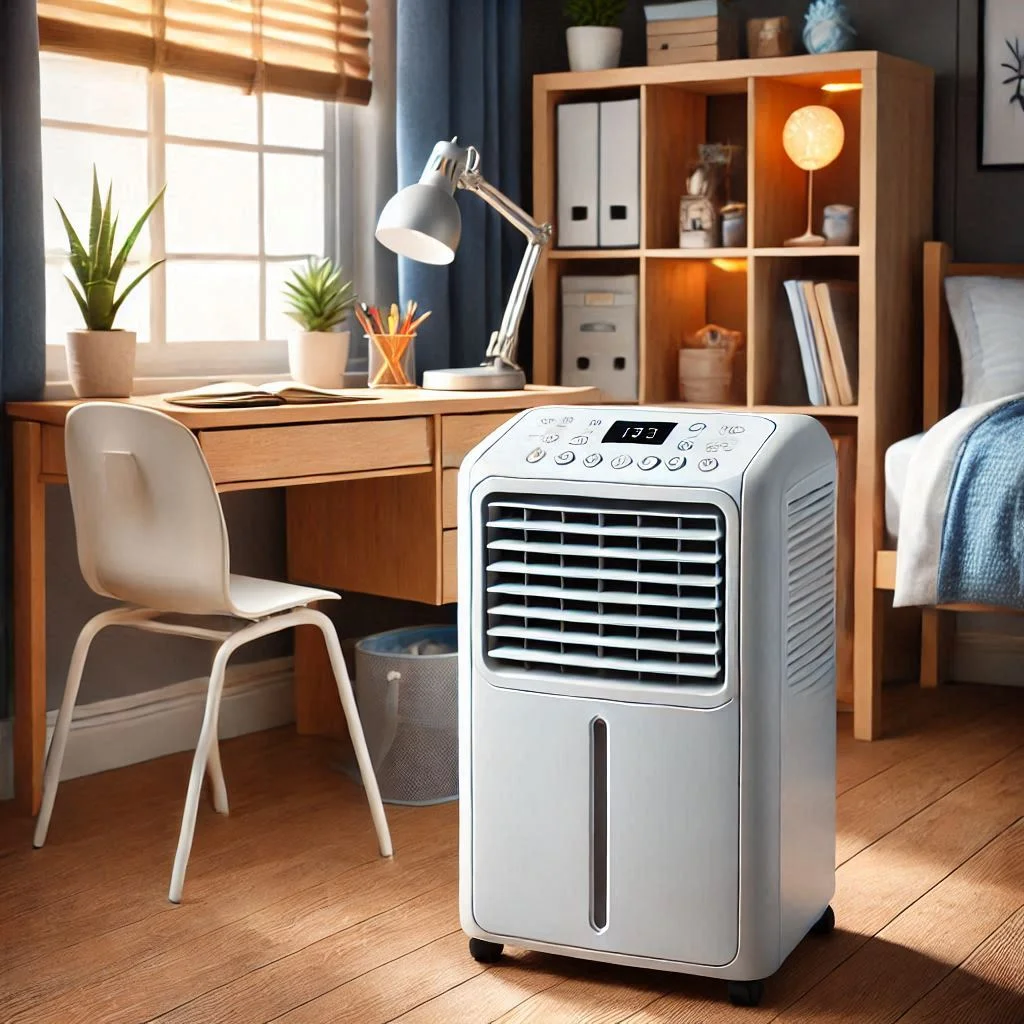
Black + Decker BPACT08WT Portable Air Conditioner
The Black + Decker BPACT08WT is a highly rated portable air conditioner that offers reliable performance for smaller dorm rooms (up to 200 square feet). With a 8,000 BTU cooling capacity, this unit is ideal for students looking for an affordable and efficient solution to combat dorm room heat.
Key Features:
- Cooling Capacity: 8,000 BTUs, suitable for smaller dorm rooms.
- Compact Design: Lightweight and easy to move, making it perfect for tight spaces.
- Energy Efficiency: Energy Star rated, ensuring lower energy consumption.
- Multi-functional: Serves as an air conditioner, dehumidifier, and fan, giving users flexible options.
- Quiet Operation: Runs at a noise level of approximately 52 dB, which is quieter than many other portable ACs.
The BPACT08WT is a budget-friendly choice that doesn’t sacrifice performance, making it ideal for students who need effective cooling without spending a fortune.
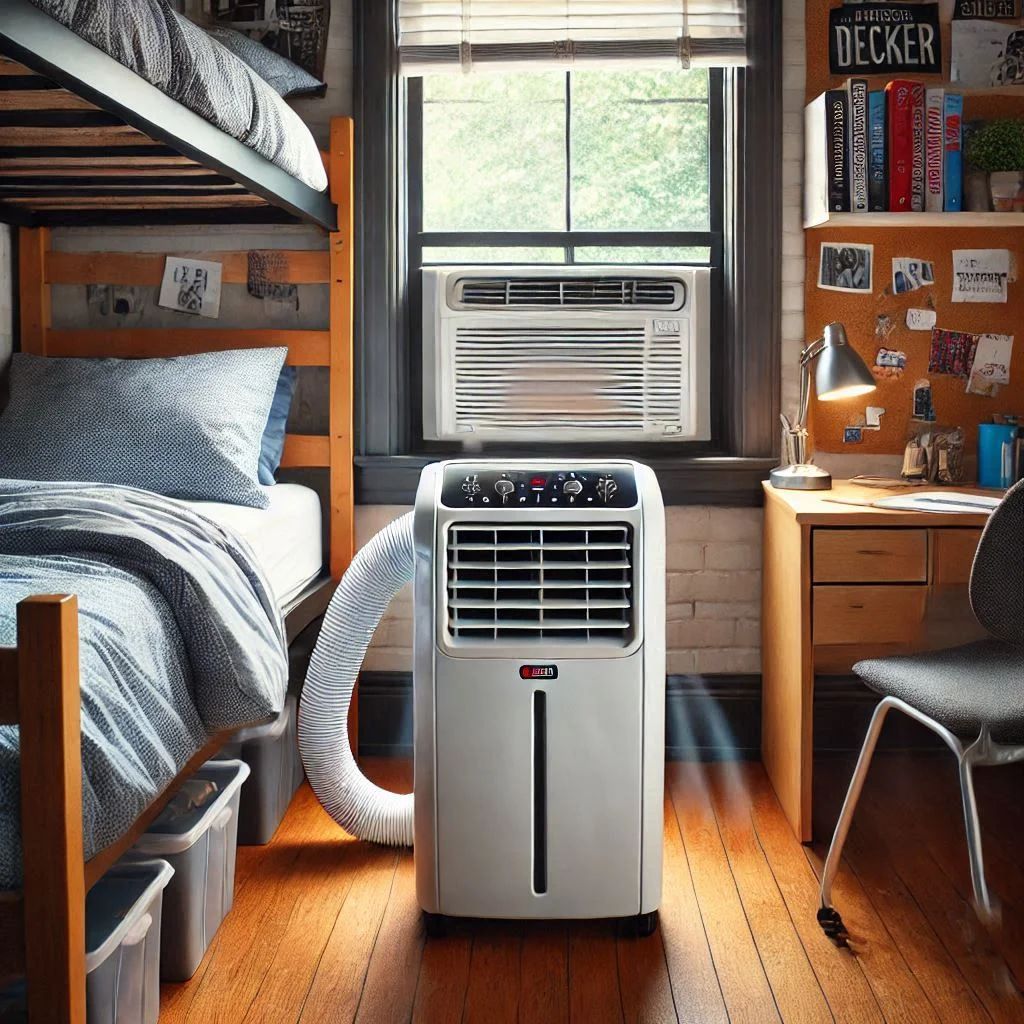
Portable Evaporative Cooler with Fan by Honeywell
While evaporative coolers aren’t technically air conditioners, the Honeywell Portable Evaporative Cooler with Fan provides an excellent alternative for cooling your dorm room, especially in dry climates. Unlike traditional air conditioners, this cooler uses water to cool the air, making it an eco-friendly option for students seeking an alternative to refrigerant-based cooling.
Key Features:
- Cooling Technology: Uses evaporative cooling, which is energy-efficient and eco-friendly.
- Compact & Portable: Easy to move around with lightweight design.
- Multiple Functions: Combines a fan and cooler in one unit, and also includes oscillating features for better airflow.
- Eco-Friendly: Operates without the need for chemicals or refrigerants, making it more environmentally conscious.
- Ideal for Dry Climates: Best suited for dorm rooms in areas with low humidity, as it relies on water evaporation to cool the air.
This evaporative cooler is perfect for students who live in drier areas or who are looking for a more energy-efficient, eco-friendly cooling option.
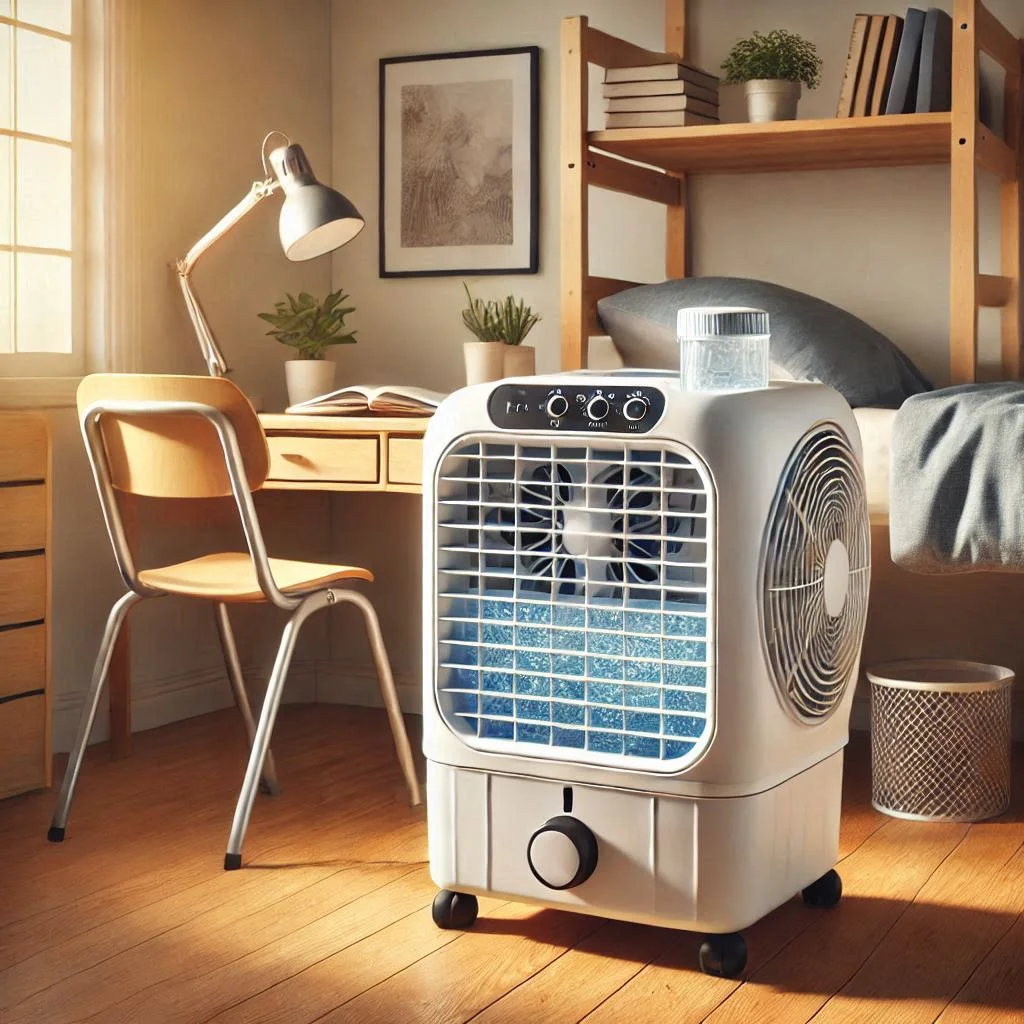
Air Cooler vs. Portable Air Conditioners
When it comes to cooling your dorm room, there are two popular options: air coolers and portable air conditioners. While both devices serve the same purpose — keeping your space cool — they work in very different ways and have distinct advantages and disadvantages. Understanding the differences between these two options will help you make the best choice for your needs, budget, and room size.
Differences and Pros/Cons for Dorm Rooms
1. Cooling Method
- Portable Air Conditioners: Portable air conditioners work by using refrigerants to absorb heat from the air and then expelling the hot air through a vent. They can cool the room to a significantly lower temperature, making them ideal for very hot days or larger spaces.
- Pros:
- Effective Cooling: Can cool rooms to much lower temperatures.
- Humidity Control: Many models also dehumidify the air, which is useful in humid environments.
- Quiet Operation: Newer models are designed to operate with minimal noise, making them more suitable for dorm rooms.
- Cons:
- Energy Consumption: Consumes more power than an air cooler.
- Requires Venting: Needs to be placed near a window or vent for proper air circulation.
- Pros:
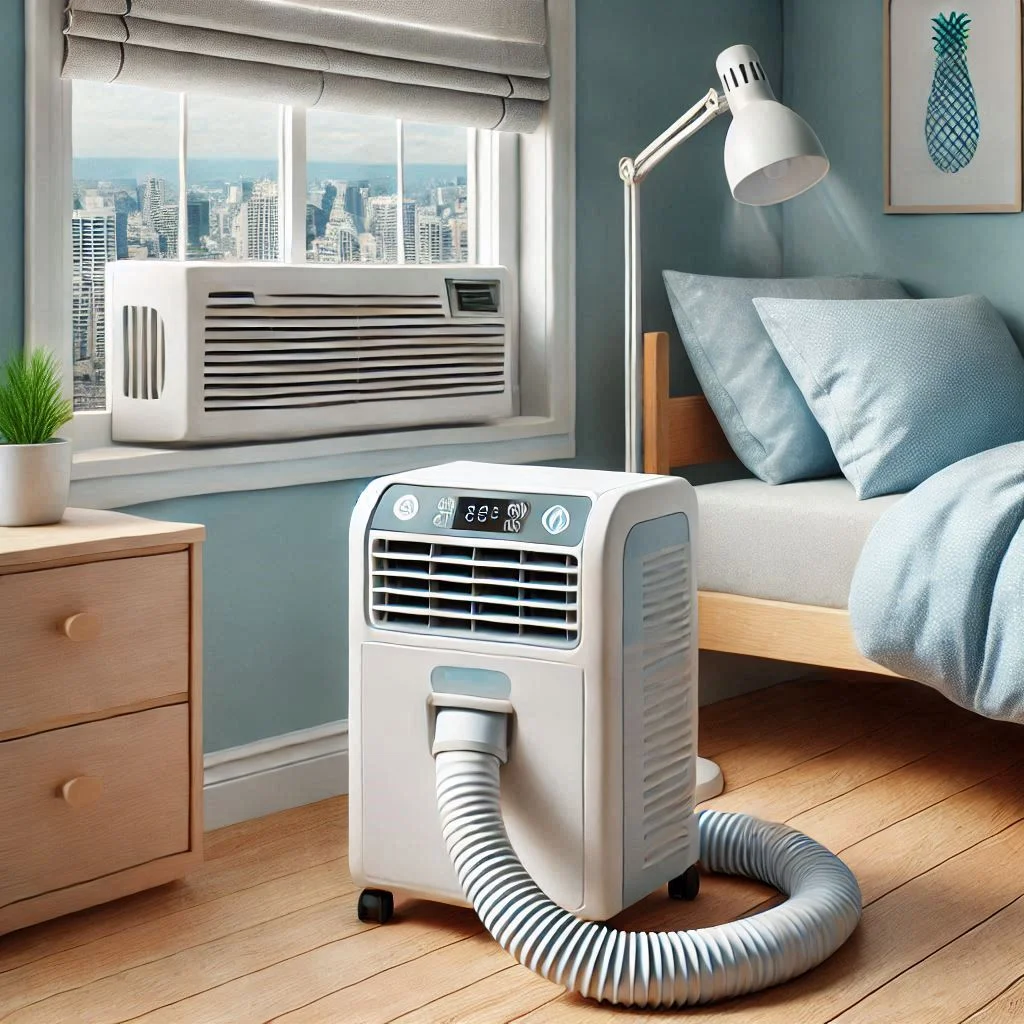
- Air Coolers: Air coolers, or evaporative coolers, use water to cool the air. They work by drawing warm air into the unit, passing it through water-soaked pads, and blowing out cooler air. This process works well in dry climates but is less effective in humid environments.
- Pros:
- Energy Efficient: Air coolers use less electricity compared to air conditioners.
- Eco-friendly: Uses water instead of refrigerants, making it more environmentally friendly.
- No Installation Required: Easier to use and move around without needing a window for venting.
- Cons:
- Limited Cooling: Doesn’t cool the air as effectively as an air conditioner, especially in very hot or humid climates.
- Not Effective in Humid Conditions: If you live in a humid area, an air cooler will not be as efficient because the air already contains a high level of moisture.
- Pros:
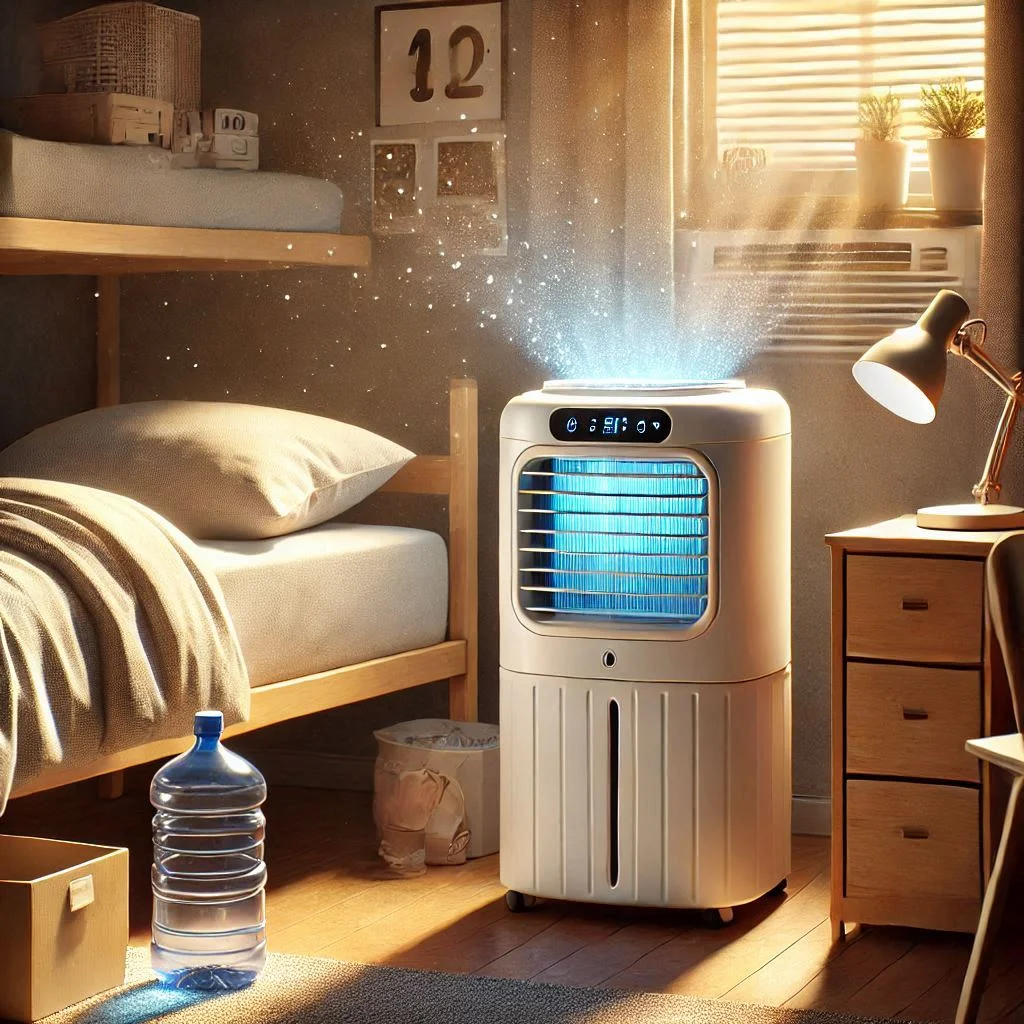
2. Ideal Use for Dorm Rooms
- Portable Air Conditioners: Ideal for larger dorm rooms or rooms with higher humidity. They provide significant cooling and can regulate the temperature more effectively. However, since they require venting, they are best used in rooms with a window or venting option.
- Best for: Students living in humid or extremely hot climates who need a cooler environment to sleep or study.
- Example Use: Cooling a larger room during the summer months to ensure comfort and productivity.
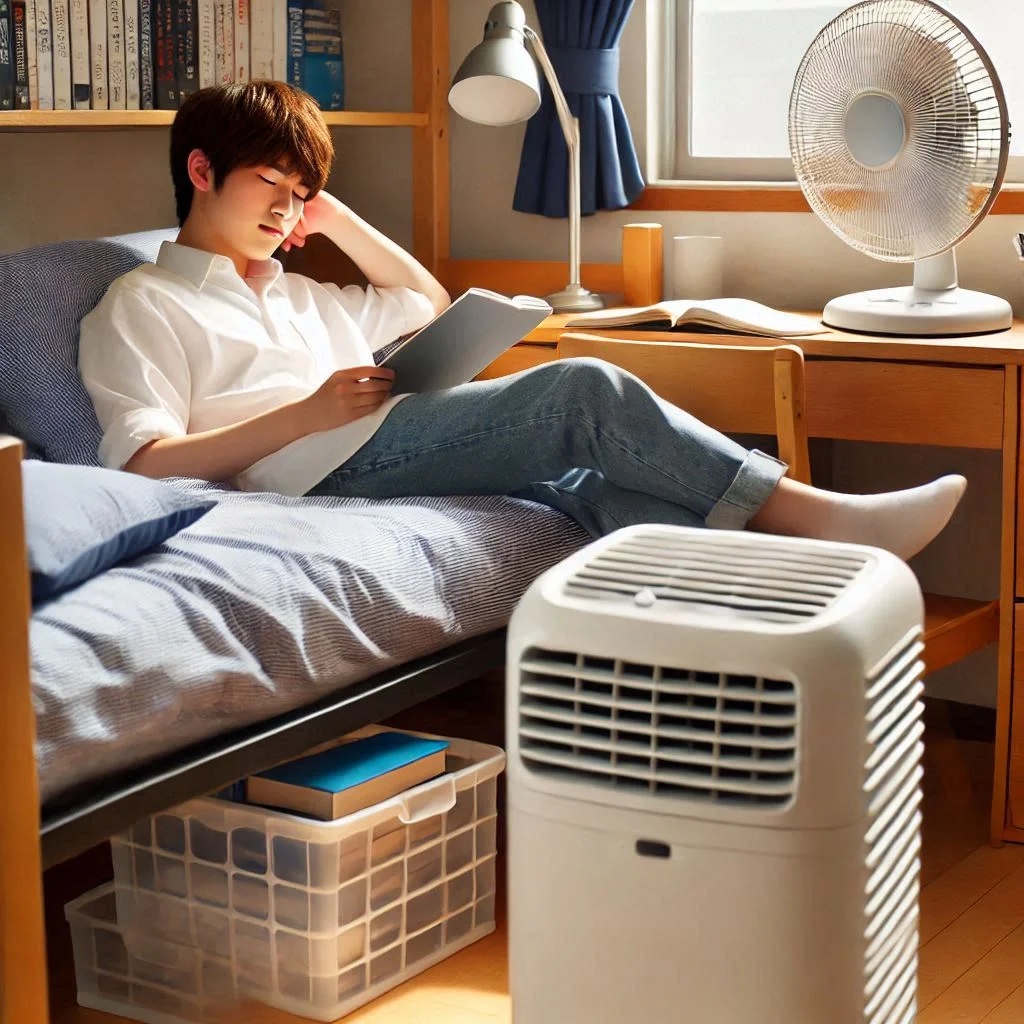
- Air Coolers: Best suited for small dorm rooms or dry climates. They are more compact and mobile, making them easy to store and move around. Air coolers also add moisture to the air, which can be beneficial in dry areas but may not be sufficient for extreme heat.
- Best for: Students in dry climates or those who only need light cooling during mild weather.
- Example Use: Keeping a small dorm room comfortable during mild summer days or enhancing air quality in dry environments.
3. Noise Level
- Portable Air Conditioners: While portable air conditioners can be a bit noisy, newer models are designed to be quieter. Many air conditioners have noise reduction technology, operating at sound levels of 50-55 dB, which is relatively quiet for most users.
- Ideal for: Students who need to sleep or study in a quiet environment.
- Air Coolers: Generally quieter than portable air conditioners, as they use a fan-based system to circulate air. They operate at sound levels of around 45-50 dB, which is ideal for light, background noise while studying or sleeping.
- Ideal for: Students who are sensitive to noise and prefer a quieter, more peaceful environment.
4. Maintenance and Cost
- Portable Air Conditioners: Maintenance includes cleaning or replacing the filter and ensuring that the drainage system is functioning. These units are typically more expensive upfront and have higher electricity bills due to their energy consumption.
- Initial Cost: Higher, with some units ranging from $300–$600.
- Maintenance: Requires regular cleaning and occasional servicing for refrigerant.
- Air Coolers: Air coolers are more affordable both in terms of initial cost and energy bills. They require minimal maintenance, mostly involving cleaning the water tank and changing the cooling pads periodically.
- Initial Cost: Lower, typically ranging from $100–$300.
- Maintenance: Easier to maintain, with fewer components requiring attention.
How to Build a DIY Dorm Room Air Conditioner
Building a DIY dorm room air conditioner can be a cost-effective and innovative way to cool down your room, especially if you’re on a tight budget. While this homemade air conditioner won’t compete with professional units, it can provide relief during hot and humid days, particularly in smaller spaces.
Step-by-Step Guide to Building a DIY Air Conditioner
- Materials Needed:
- A styrofoam cooler or any other insulated box
- PVC pipes (for ventilation)
- Frozen water bottles or ice packs
- A fan
- Duct tape or strong adhesive
- Scissors or a utility knife
- Instructions:
- Prepare the Cooler: Cut two holes in the cooler — one to fit the fan and the other for the PVC pipe.
- Install the Fan: Place the fan at the cooler’s opening and seal it with duct tape. The fan will blow air into the cooler and help circulate the cool air in the room.
- Insert Ice Packs or Frozen Bottles: Fill the cooler with frozen water bottles or ice packs. These will provide the cool air when the fan blows over them.
- Attach the Vent Pipe: Connect the PVC pipe to the other hole and direct it towards the room. This pipe will serve as the exhaust, allowing the cool air to flow into the dorm room.
- How It Works: The fan will blow air across the ice packs, which will cool the air before circulating it through the vent pipe into the room. This DIY air conditioner works best for small dorm rooms and during times when the room needs light cooling.
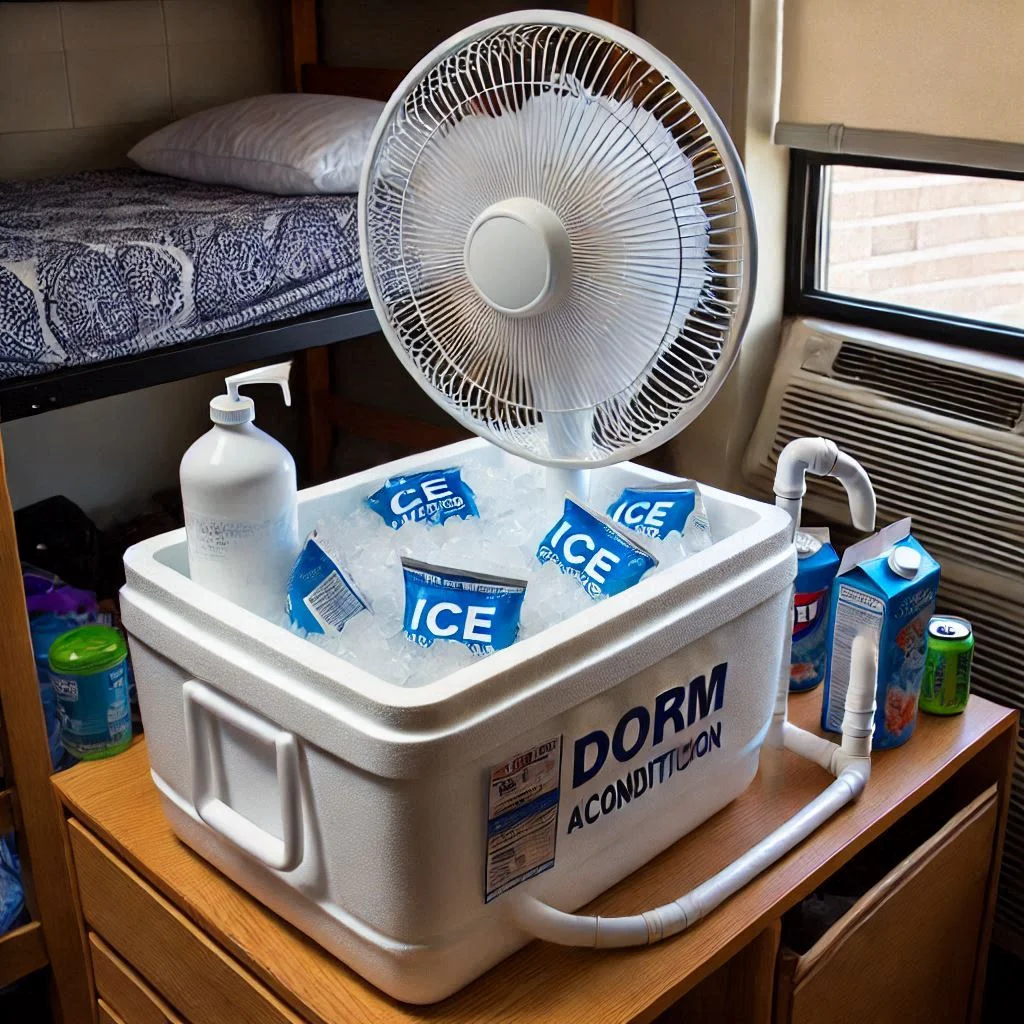
How to Cool a Dorm Room Without an Air Conditioner
If you’re looking for ways to keep your dorm room cool without an air conditioner, there are several simple, cost-effective methods that can help you beat the heat. These techniques utilize basic items you may already have at home, helping you stay cool and comfortable during the warmer months.
1. Purchase a Fan
Fans are one of the most affordable and effective ways to keep your dorm room cool. Whether you use a table fan, tower fan, or box fan, fans circulate air in the room, creating a wind-chill effect that can make the room feel cooler.
- Tip: Place your fan near the window to bring in cooler outdoor air or point it towards the door to help air flow through the room.
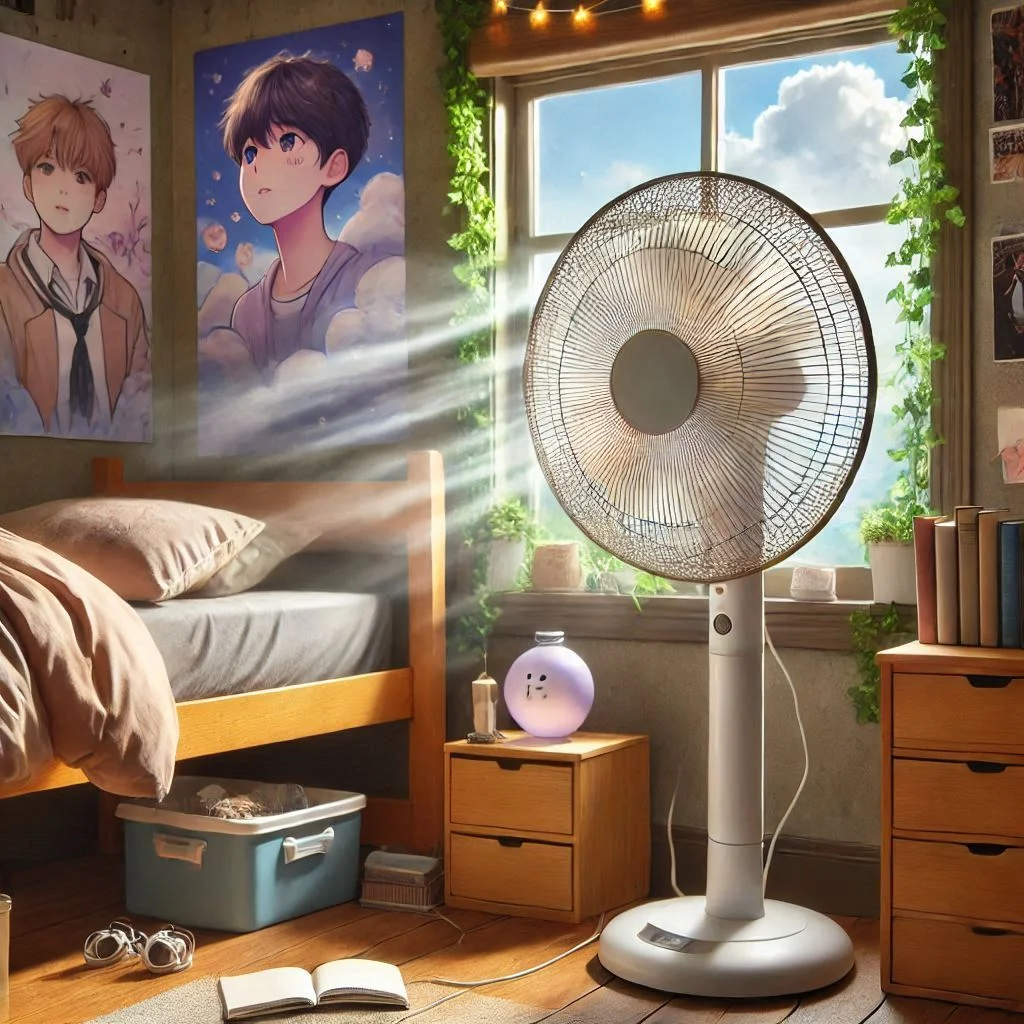
2. Keep Your Blinds Closed
Sunlight can significantly increase the temperature inside your dorm room. By keeping your blinds closed or using blackout curtains, you can block out the sun’s rays and keep the room cooler.
- Pro Tip: In the morning, close the blinds to prevent the room from heating up during the hottest part of the day. Open them during the cooler evening hours to let in some fresh air.
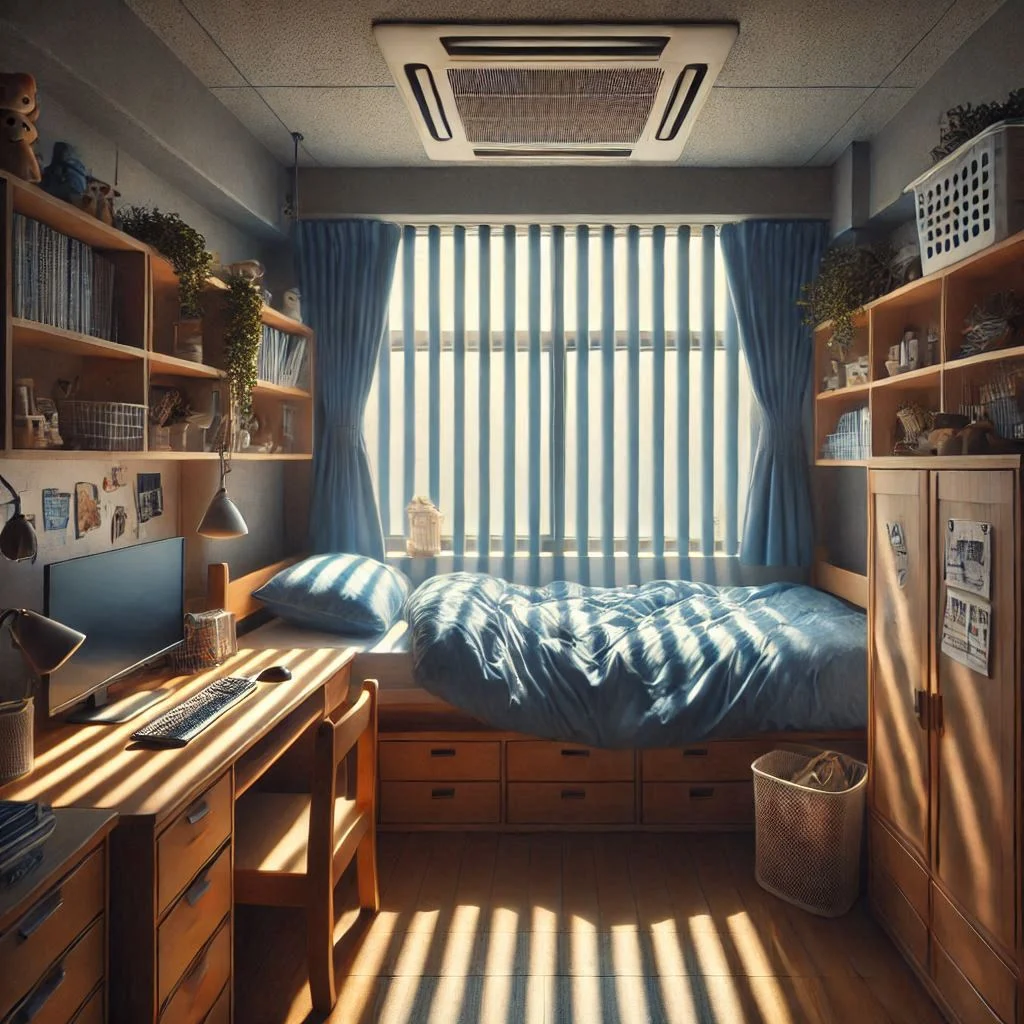
3. Invest in a Cold Mist Humidifier
A cold mist humidifier not only adds moisture to the air but also lowers the room’s temperature. This method works especially well in dry climates, where the air is hot but lacks moisture. The cool mist helps regulate the room’s temperature and makes breathing easier.
- Pro Tip: Place the humidifier near the fan to help distribute the cool mist evenly across the room.
4. Turn Off Unnecessary Electrical Appliances
Electrical appliances generate heat, so it’s essential to turn off unnecessary electronics. Items such as laptops, lights, and television can contribute to the overall temperature of the room.
- Tip: Unplug devices when not in use and use energy-efficient LED lights that produce less heat.
5. Shower Before Bed
Taking a cool shower before bed can help lower your body temperature and make it easier to fall asleep in a warm dorm room. The evaporation of water from your skin can keep you feeling cooler for hours after the shower.
- Pro Tip: If you don’t have access to air conditioning, taking a cool shower before bed can be a quick and natural way to stay comfortable all night.
Important Considerations for Buying a Portable Air Conditioner for Dorm Rooms
When it comes to staying cool in your dorm room, a portable air conditioner can be a great solution. However, with so many options available, it’s important to consider a few factors to make the best purchase decision. From cost to efficiency, there are key aspects to look at to ensure your investment meets your needs.
How Much Does a Portable Air Conditioner Cost?
The cost of a portable air conditioner can vary significantly depending on its size, features, and brand. On average, you can expect to pay anywhere from $200 to $700 for a decent unit.
- Budget-Friendly Models: The lower-end models, generally offering between 5,000 and 8,000 BTUs, typically cost around $200-$300. These are suitable for smaller dorm rooms or if you’re just looking for a unit that offers basic cooling.
- Mid-Range Models: Units offering 10,000 to 12,000 BTUs tend to cost around $350-$500. These offer more cooling power and may come with added features like Wi-Fi connectivity or smart controls.
- High-End Models: If you need a unit for larger spaces or want additional features like a dehumidifier or advanced air filters, expect to pay $500 and up. These models can cool larger dorm rooms or apartments effectively.
When choosing your unit, it’s important to consider both your budget and the cooling capacity needed for your space.
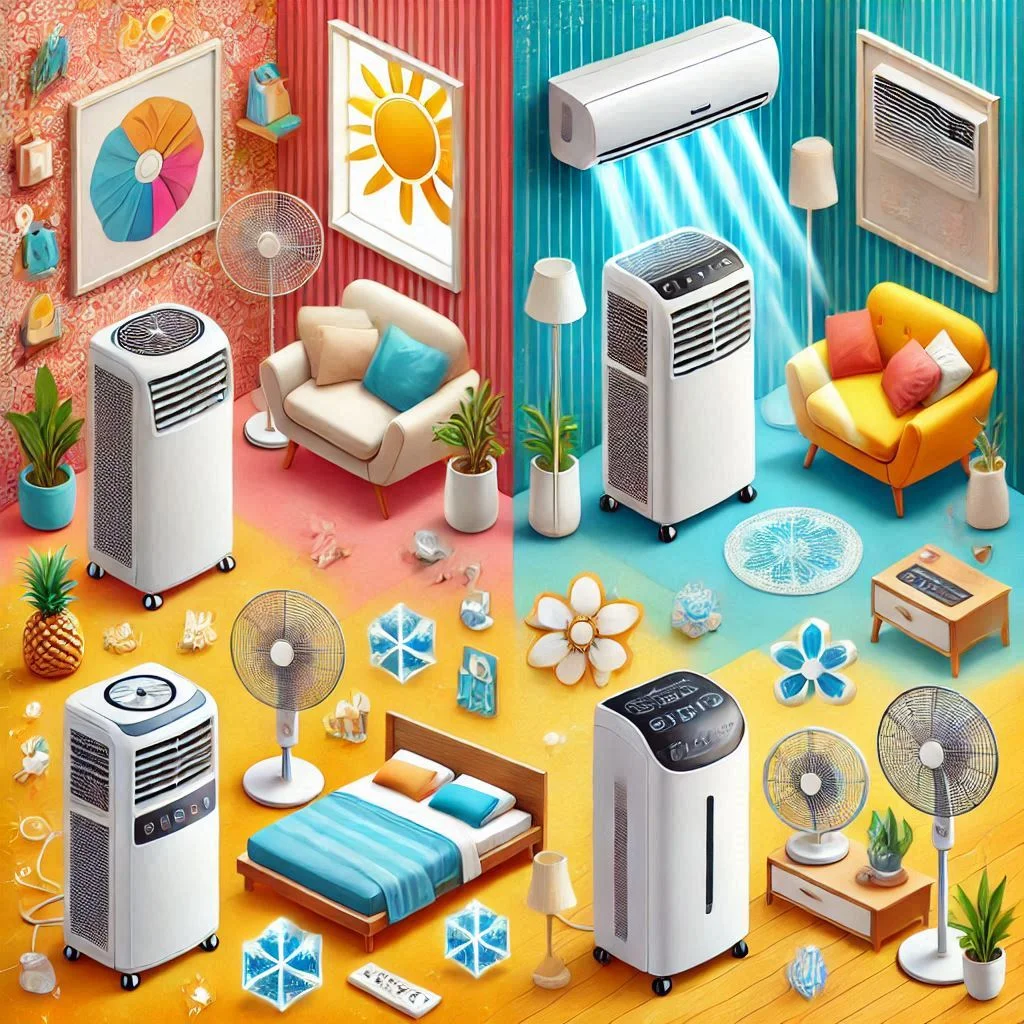
What Type of Portable Air Conditioner is Best for Dorm Rooms?
Choosing the right type of portable air conditioner depends on several factors, including your room’s size and the features you prioritize.
- Basic Portable AC: These are simple units that offer straightforward cooling. If you don’t need extra features, this type is an affordable and effective choice.
- Smart Portable AC: Some portable air conditioners come with Wi-Fi connectivity, allowing you to control your AC remotely via a mobile app or voice assistant. This is a great option for tech-savvy students.
- Dual Hose Portable AC: For better efficiency, especially in larger rooms, a dual-hose system is preferable. This type draws air from outside and exhausts hot air outside as well, offering faster cooling.
- AC with Dehumidifier Function: If you live in a humid climate, a portable AC with dehumidifying capabilities can help improve air quality and prevent mold and mildew buildup in your dorm room.
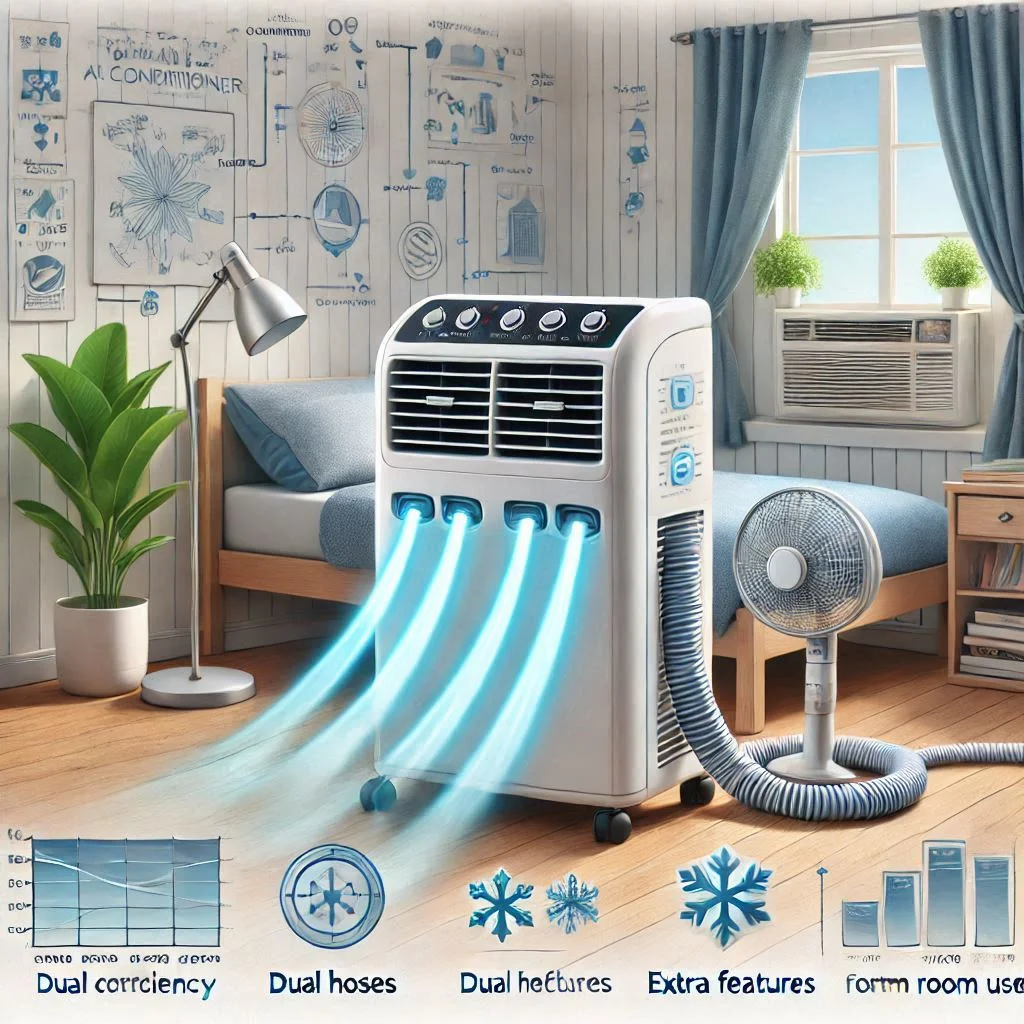
How Many BTUs Should a Portable AC Have for a Dorm Room?
The BTU rating (British Thermal Units) indicates the cooling capacity of a portable air conditioner. For a dorm room, you’ll want to select a unit that’s appropriately sized to cool the space effectively.
- Room Size 100 to 150 sq. ft: A 5,000 to 6,000 BTU portable AC is sufficient for small dorm rooms.
- Room Size 150 to 250 sq. ft: For slightly larger rooms, a 7,000 to 8,000 BTU unit will provide optimal cooling.
- Room Size 250 to 350 sq. ft: If your dorm room is larger or has high ceilings, a 10,000 to 12,000 BTU portable air conditioner will keep the space comfortable.
Remember, the higher the BTU, the more powerful the air conditioner is. Choosing the right size based on your room’s square footage ensures you don’t overpay for a unit that’s too large or end up with a unit that’s insufficient for your needs.
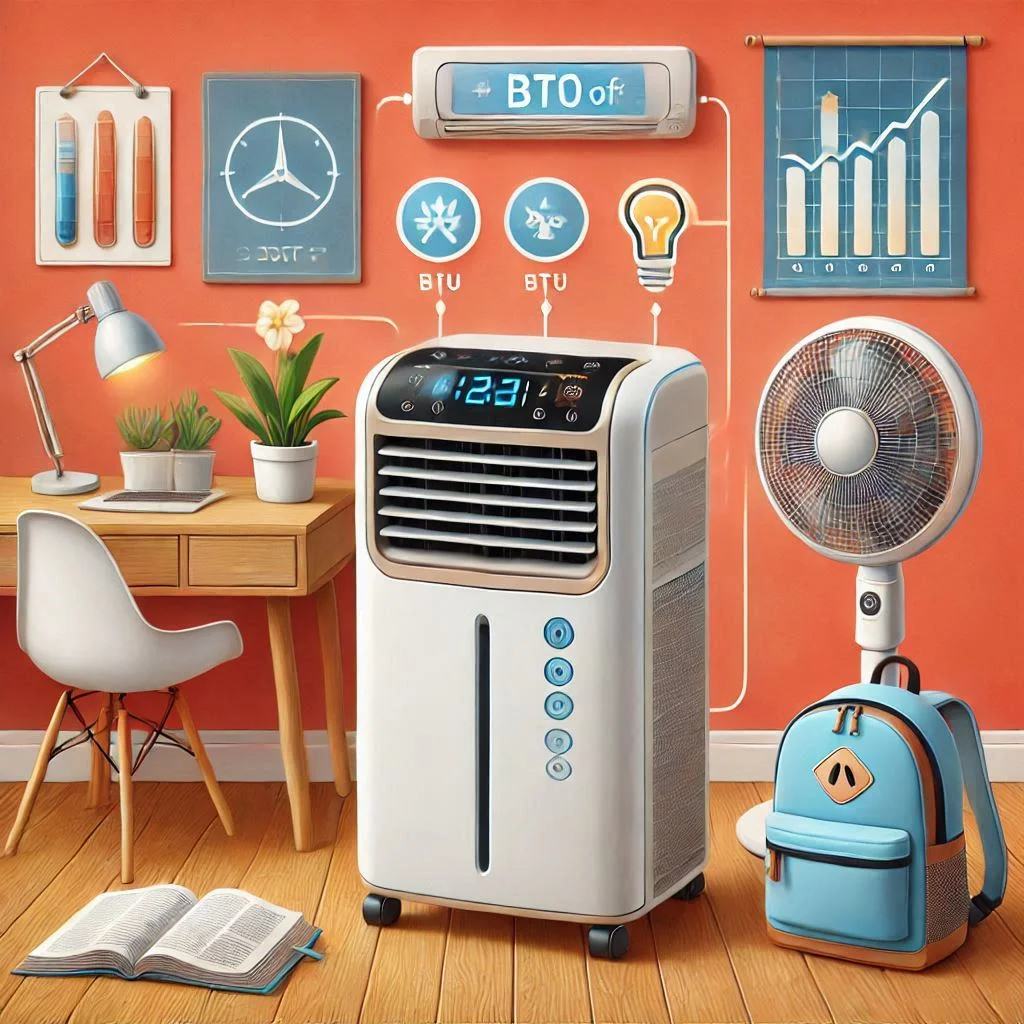
Do Portable Air Conditioners Need to Be Ventilated Out of a Window?
Yes, portable air conditioners need to be ventilated to exhaust hot air out of the room. This is usually done through a window venting kit, which is included with most portable AC units.
- Why Ventilation is Important: Without proper ventilation, the unit will recirculate the hot air back into the room, rendering it ineffective. Venting the hot air outside allows the portable AC to work efficiently and cool the room.
- Installation: The venting process is straightforward. Simply attach the exhaust hose to the AC unit and connect it to the window vent kit. Most kits can be adjusted to fit different window sizes and types.
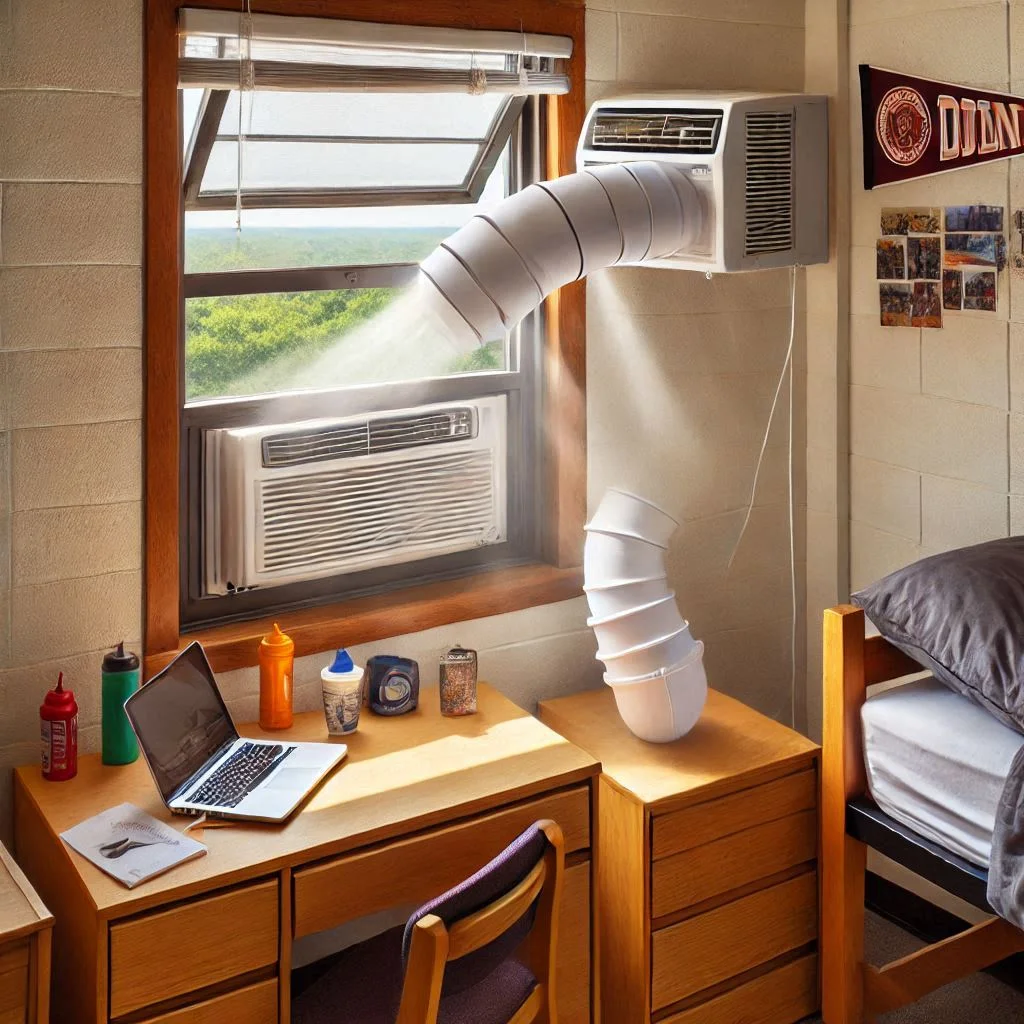
Are Portable Air Conditioners as Good as Window Units?
While both portable air conditioners and window units provide effective cooling, there are key differences between the two.
- Portable Air Conditioners: These units are versatile and can be moved from room to room. They are ideal for dorm rooms because they don’t require permanent installation and can be set up quickly. However, portable units tend to be less energy-efficient than window units.
- Window Air Conditioners: These are typically more energy-efficient and have a higher cooling capacity. However, they are permanent fixtures and require a window installation, which may not be suitable for dorm rooms that have limited window options or if you’re not allowed to install a unit.
For dorms, a portable AC is often the better choice due to its flexibility, while a window unit may be better suited for permanent living situations with the ability to install it in a window.
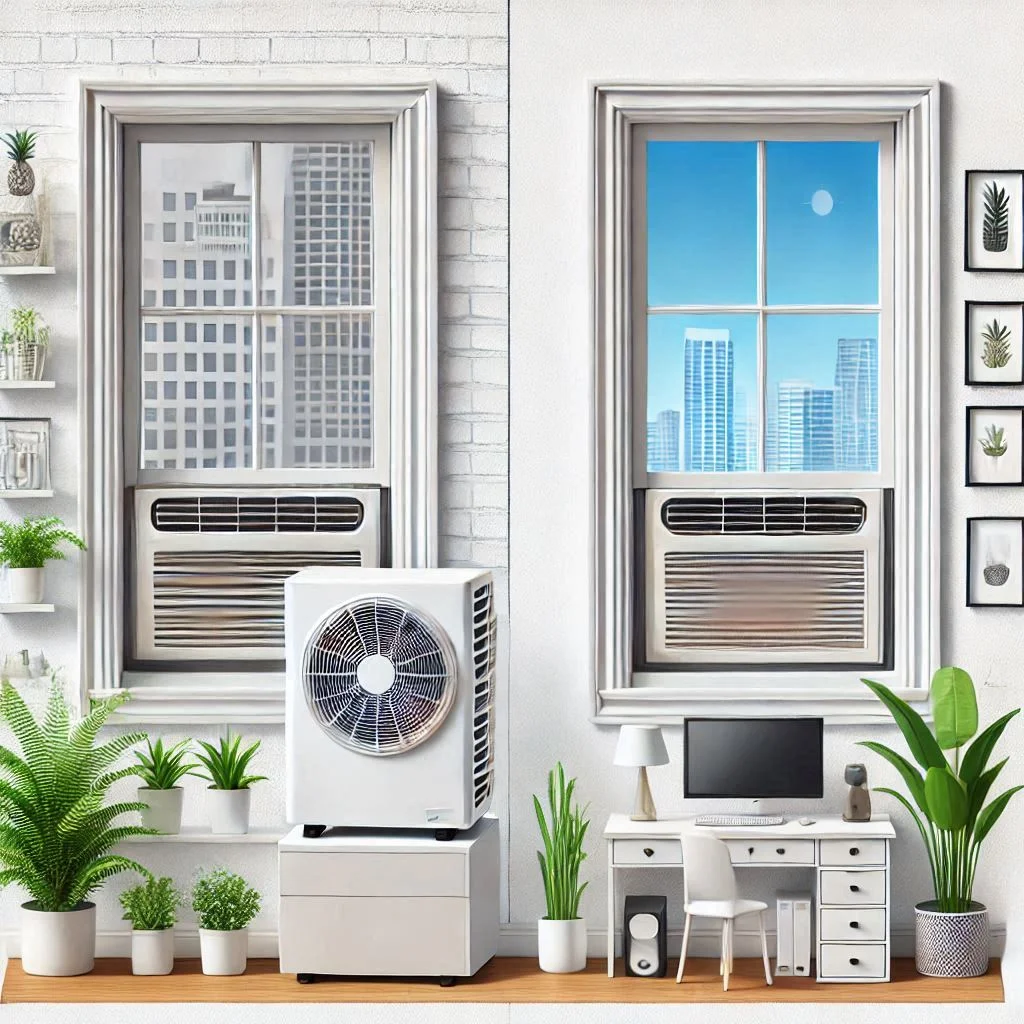
FAQ: Portable Air Conditioners for Dorm Rooms
What’s the best portable air conditioner for small dorm rooms?
When selecting the best portable air conditioner for small dorm rooms, the key is to choose a unit that provides efficient cooling without overwhelming the space. Here are some excellent options for smaller dorms:
- FHPH132AB1 Portable Room Air Conditioner by Frigidaire: With a 6,000 BTU cooling capacity, this model is perfect for dorm rooms up to 250 square feet. It is compact, easy to move, and provides solid cooling performance.
- Black + Decker BPACT08WT Portable Air Conditioner: A popular choice for small spaces, this 8,000 BTU unit is ideal for rooms up to 200 square feet. It also features a dehumidifier and fan mode, offering versatility for year-round comfort.
- Honeywell Portable Evaporative Cooler with Fan: Though not technically an air conditioner, this evaporative cooler works well for cooling in dry climates and is quieter than traditional AC units.
Look for a unit that balances cooling power with size and portability to ensure the best fit for your dorm room.
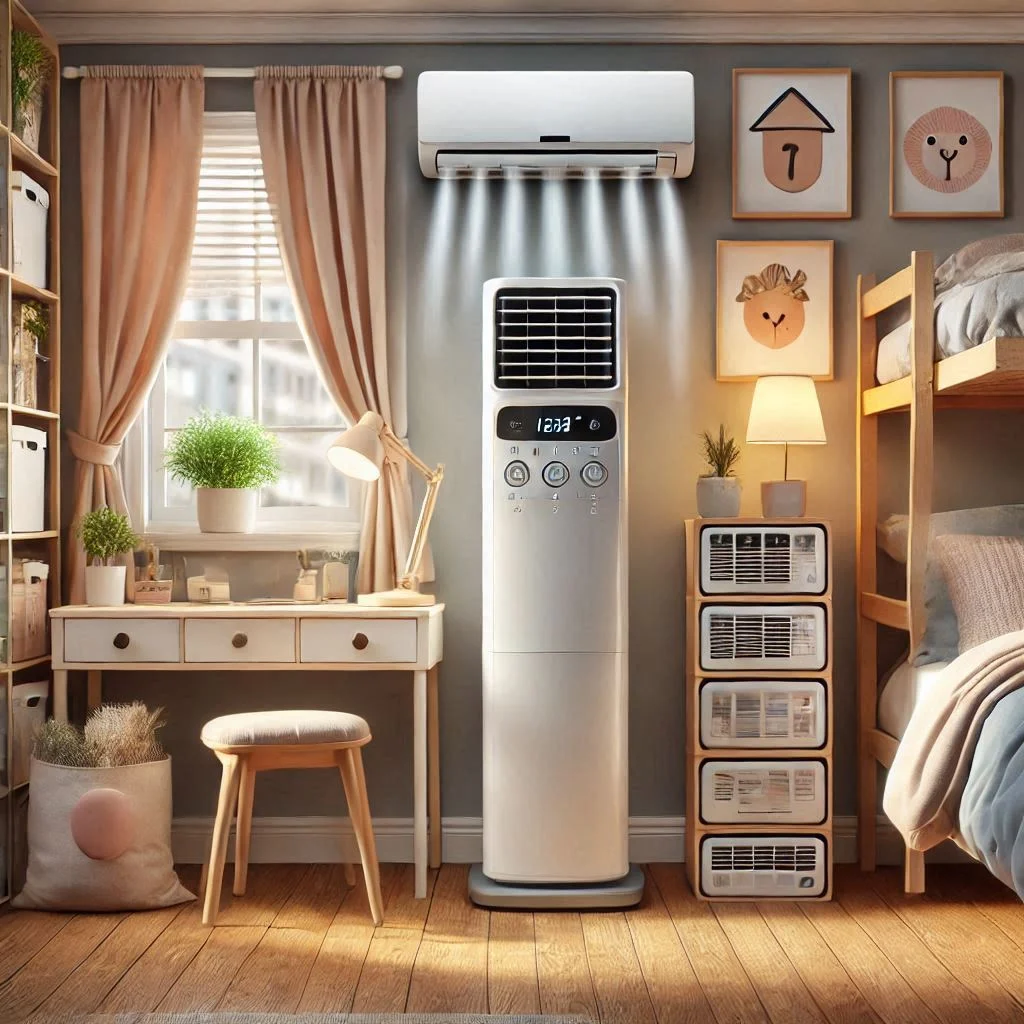
Can portable air conditioners be used without venting out a window?
No, portable air conditioners must be vented outside to work efficiently. The reason is that portable AC units generate hot air that needs to be expelled from the room to maintain a cooling effect. Without proper ventilation, the hot air will recirculate, making the AC less effective.
- Window Venting Kit: Most portable AC units come with a window venting kit that makes it easy to install the exhaust hose and vent the hot air out of the window.
- Alternative Venting: In the absence of a window, it’s possible to use other methods, such as venting through a doorway or a wall opening, but this can be less efficient.
Proper venting is crucial for the performance and energy efficiency of the unit.
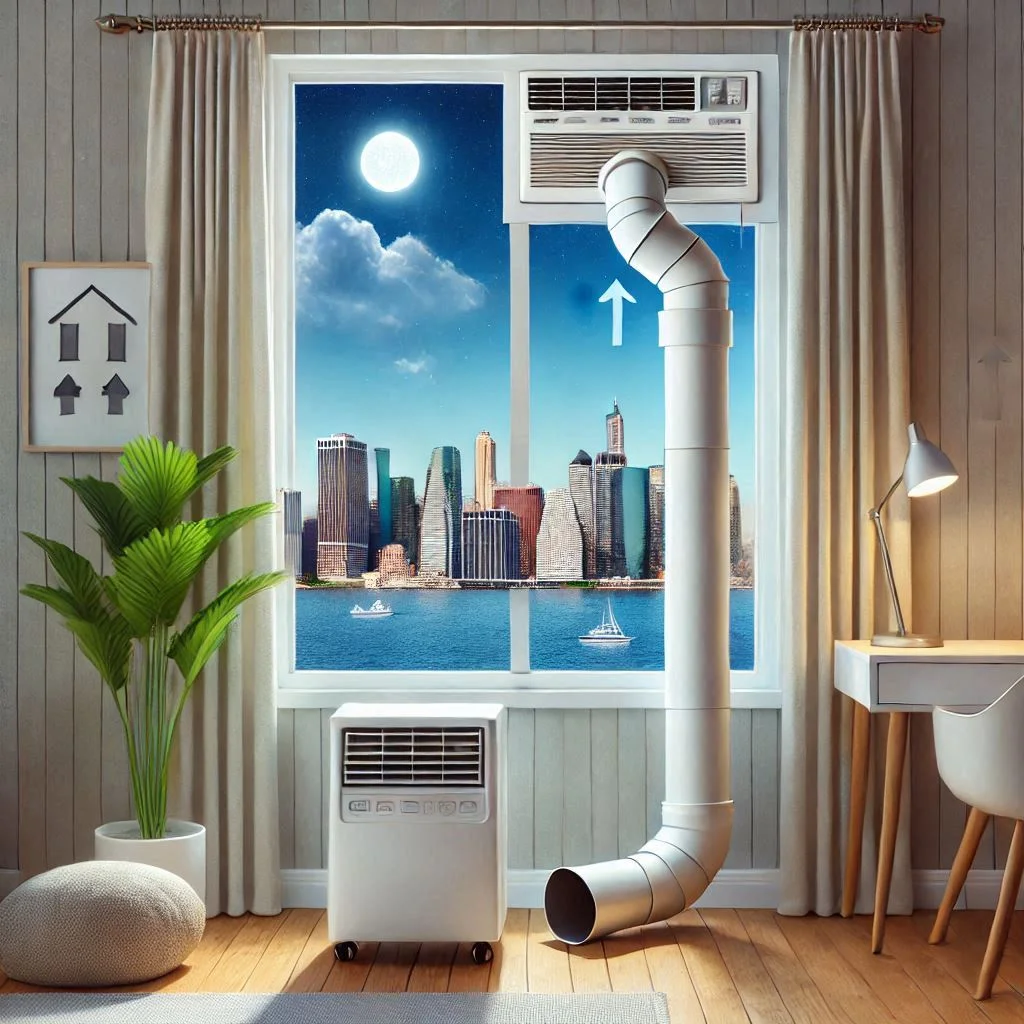
How can I reduce the noise of my portable AC in a dorm room?
Noise is a common concern when using portable air conditioners in dorm rooms. However, there are several strategies to reduce the noise level:
- Choose a Quieter Unit: Some portable air conditioners are specifically designed to operate more quietly. Look for units with a low decibel rating (less than 50 dB). Units like the Black + Decker BPACT08WT and De’Longhi Pinguino models are known for being quieter options.
- Place the Unit Away from Your Bed: Position your portable AC unit as far from your sleeping area as possible to reduce noise disturbance. You can use extension hoses if needed.
- Use Sound Dampening Materials: If the noise is still an issue, consider placing the unit on a soft surface like a rug or foam mat to absorb some of the vibrations and sound.
- Regular Maintenance: Clean and maintain your portable AC regularly. Dirty filters or obstructed vents can cause the unit to work harder, producing more noise.
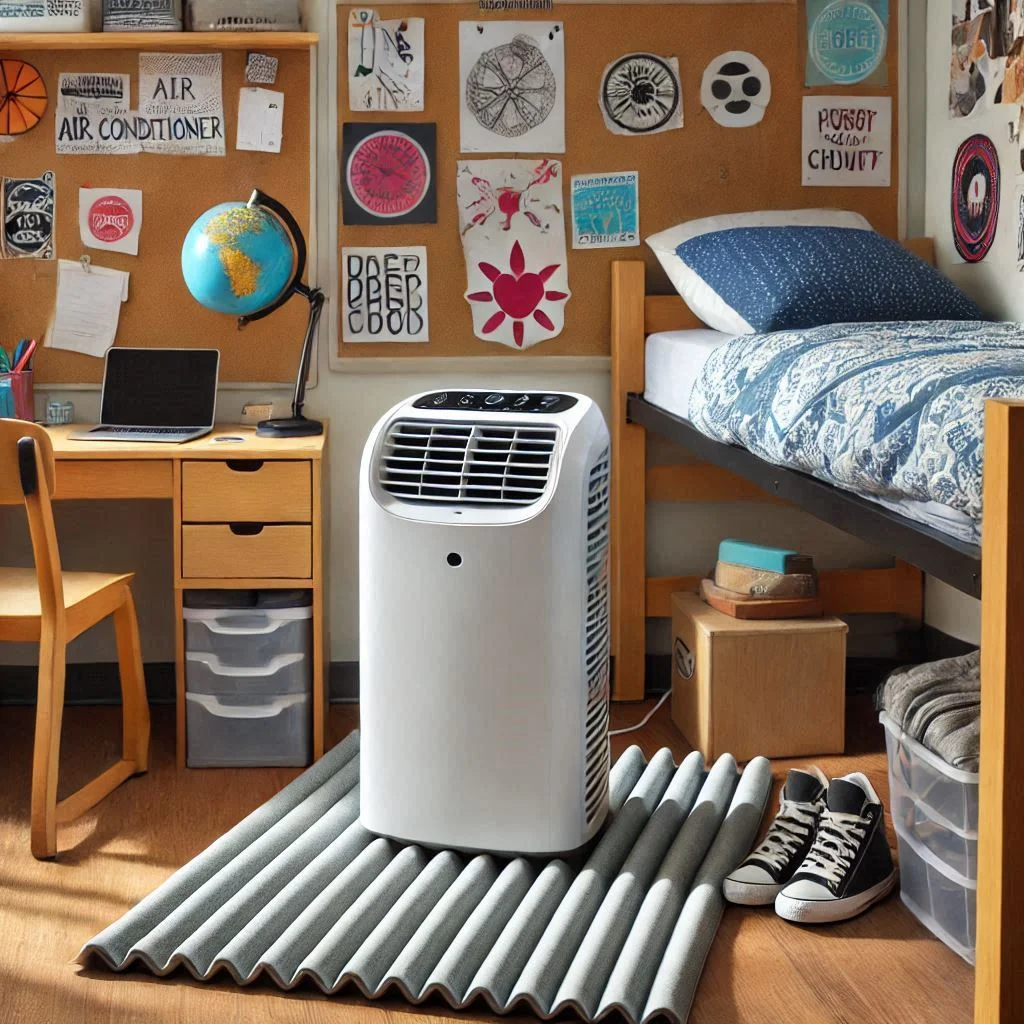
How efficient are portable air conditioners for cooling dorm rooms?
Portable air conditioners can be quite efficient at cooling dorm rooms, but their performance depends on several factors:
- BTU Rating: The higher the BTU (British Thermal Units), the more powerful the cooling. However, a unit that’s too powerful for a small space may waste energy and cause the room to feel uncomfortable.
- Energy Efficiency: Look for units with an Energy Star rating, which indicates that the AC uses less energy while providing effective cooling.
- Room Size: A portable air conditioner works best in rooms that are within the recommended square footage range. For instance, a 10,000 BTU unit will work well for a 300 square foot room but might be less efficient in a room smaller than that.
Overall, portable AC units are an efficient and practical solution for dorm rooms, especially when you match the size and capacity of the unit to your room’s needs.
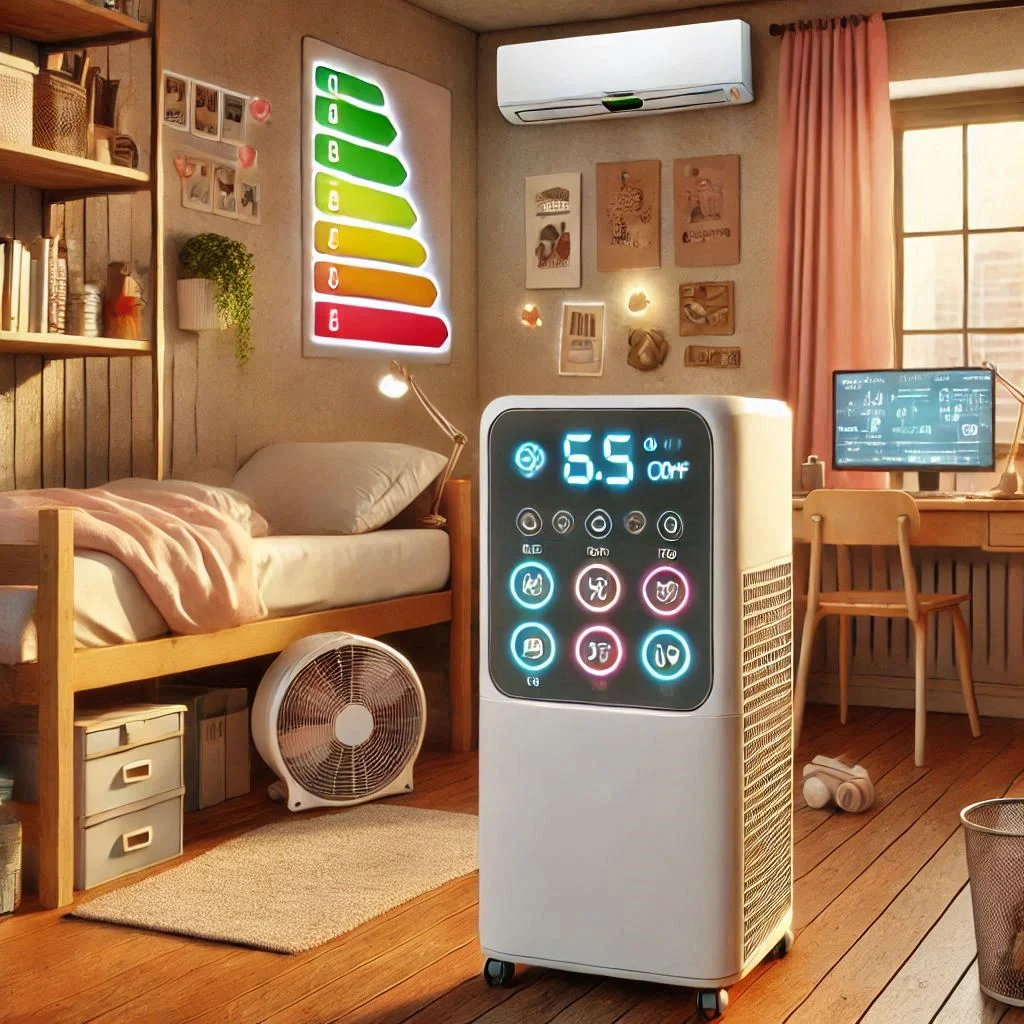
Conclusion
In conclusion, selecting the best portable air conditioner for your dorm room involves considering factors such as cooling capacity, noise level, energy efficiency, and ventilation needs. Whether you’re opting for a portable air conditioner, exploring DIY cooling methods, or comparing options like air coolers, there are plenty of solutions to keep your dorm comfortable. By carefully evaluating your room’s size and cooling needs, you can make an informed decision that ensures you stay cool without compromising on space or convenience. With the right choice, you can enjoy an efficient and peaceful environment, even during the hottest months. Keep these considerations in mind, and your dorm room will stay refreshed all year long.

